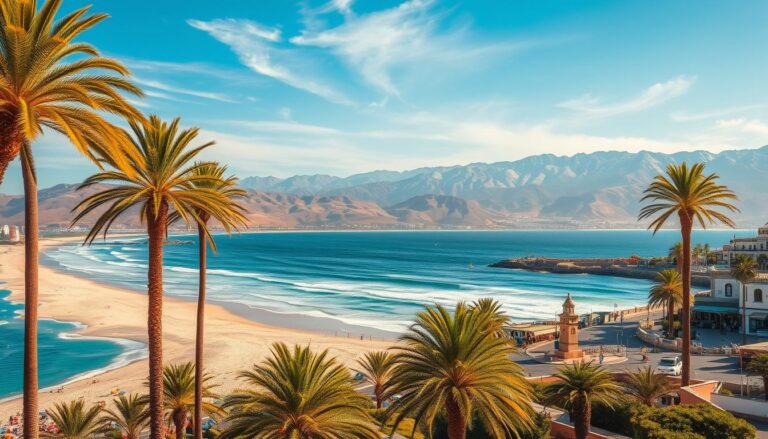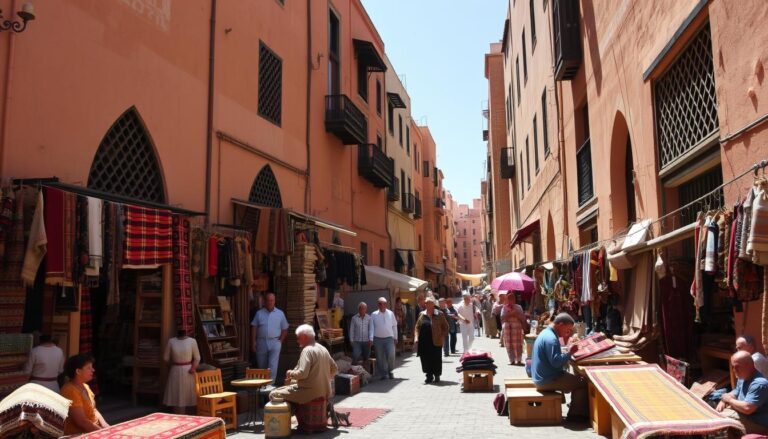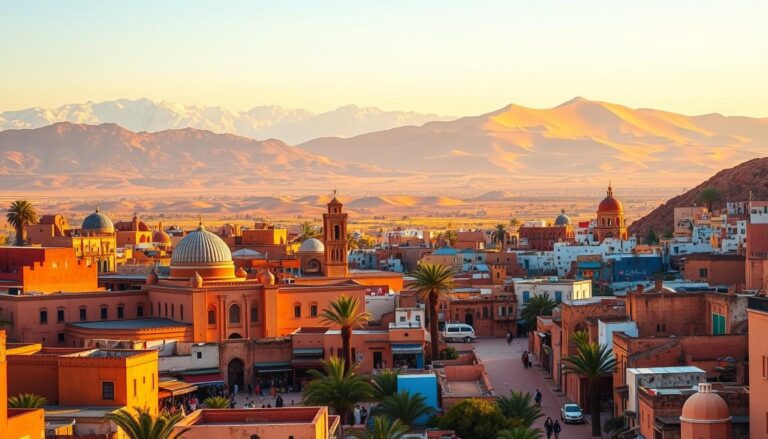Ourika Valley Travel Guide: Best Day Trip from Marrakech
Table of Contents
Ourika Valley Travel Guide: Best Day Trip from Marrakech
Did you know that just 30 minutes from Marrakech’s bustling streets lies a mountain oasis visited by over 500,000 travelers annually? This rugged escape in the High Atlas Mountains combines waterfalls, terraced farms, and Berber villages into one unforgettable experience.
At 1,500 meters above sea level, the region offers cooler air and panoramic views that feel worlds away from the city heat. The area’s name traces back to the Urika tribe, descendants of Morocco’s Almohad Dynasty, who still maintain centuries-old traditions here. You’ll find vibrant markets selling handwoven rugs and mint tea served in clay homes clinging to hillsides.
Stretching 68 kilometers toward Setti Fatma village, this destination blends adventure with cultural immersion. Hike past walnut groves to seven-tiered waterfalls, or sip almond milk with locals in earthen-walled guesthouses. It’s no wonder this route ranks as Morocco’s most accessible mountain retreat.
Key Takeaways
- Escape Marrakech’s heat in under an hour to explore waterfalls and Berber villages
- Discover ancestral traditions of the Urika tribe in cliffside communities
- Enjoy 15°F cooler temperatures at 1,500 meters elevation
- Perfect for short adventures with hiking trails and markets all reachable in a day
- Experience authentic Moroccan mountain culture without sacrificing convenience
Introduction to Your Ourika Valley Day Trip
Within moments of leaving Marrakech’s city limits, you’ll find yourself breathing crisp mountain air. The temperature plummets up to 20°C as you ascend into cooler altitudes, swapping ochre desert landscapes for terraced hillsides bursting with olive groves and wildflowers.
What to Expect on Your Journey
Your route winds through ever-changing scenery – red-earth cliffs give way to walnut forests, then seven-tiered waterfalls fed by snowmelt. Berber women in colorful headscarves tend crops while children lead goats along ancient trails. Stop at roadside stalls to taste freshly pressed argan oil or sip mint tea sweetened with local honey.
Why This Day Trip is Unforgettable
Three elements make this excursion stand out:
- Cultural immersion: Share meals with families in clay-walled homes
- Natural drama: Hike past rushing streams to panoramic viewpoints
- Sensory delights: Smell woodsmoke mingling with blooming almond trees
By sunset, you’ll understand why this region remains Morocco’s best-kept secret – a place where modern life pauses, and mountain traditions thrive.
Planning Your Journey from Marrakech
Morning light paints the Atlas peaks gold as you prepare for an efficient mountain escape. Smart timing turns this day trip into a seamless adventure where every hour counts.
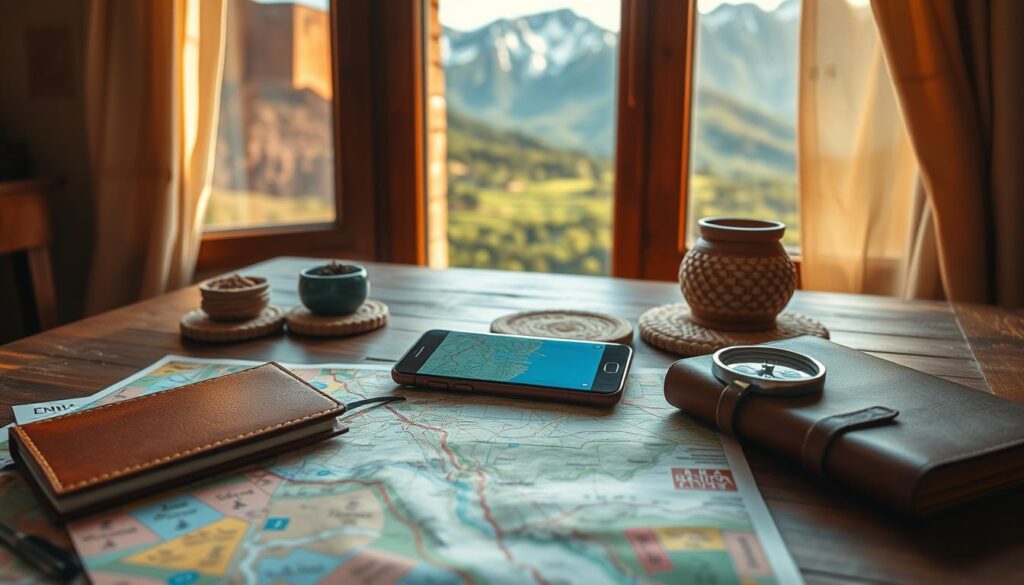
Choosing the Best Time of Day
Beat both heat waves and tour buses by departing before 9 AM. Local guide Fatima Zahra advises: “The waterfalls sparkle brightest at dawn, and village bread ovens smell sweetest then.” Early starts mean cooler trail conditions and first access to hidden swimming holes.
Essential Travel Preparations
Pack like a pro with this quick checklist:
| Category | Must-Haves | Why It Matters |
|---|---|---|
| Footwear | Ankle-support hiking shoes | Rocky paths demand stability |
| Weather Protection | SPF 50 + light jacket | UV index hits 11 in summer |
| Hydration | 2L water per person | Altitude dehydrates faster |
| Currency | 400 MAD cash minimum | No ATMs past Asni village |
Road warriors take note: The P2017 route’s hairpin turns require steady drivers. Negotiate taxi fares upfront – expect to pay 600-800 MAD roundtrip. Afternoon storms often roll in by 3 PM, so time your return drive carefully.
Keep snacks handy for energy boosts during hikes. A waterproof phone case proves priceless when snapping photos under waterfall mist. With smart prep, you’ll trade city stress for mountain magic in record time.
How to Get to Ourika Valley
Navigating from Marrakech to this mountain retreat offers choices for every travel style. Whether you prioritize budget, comfort, or cultural immersion, the journey itself becomes part of the adventure.
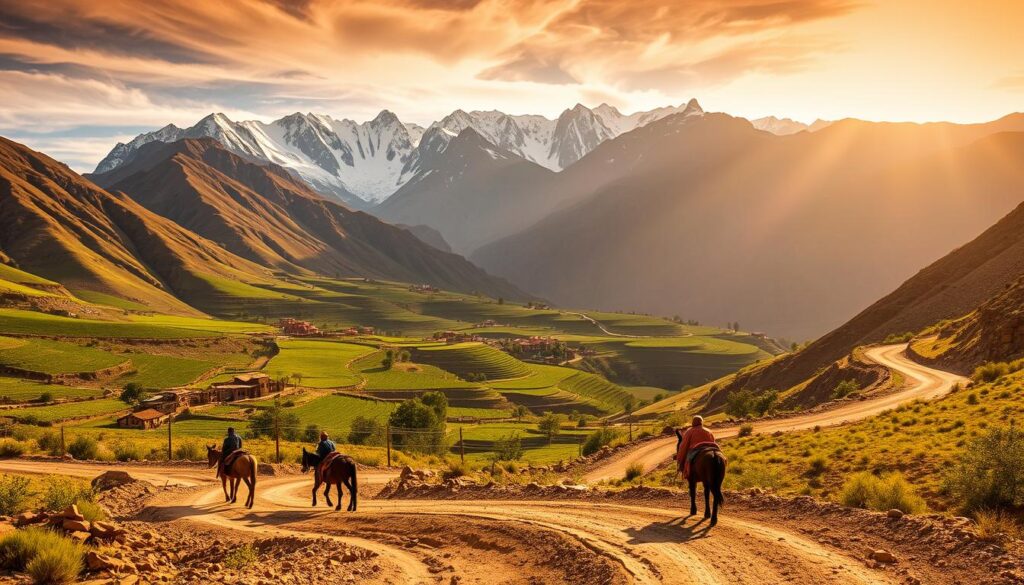
Driving, Taxi, or Public Transport Options
Budget travelers often take Bus #25 from near Jemaa el-Fnaa square. After a 1-hour ride, switch to a shared taxi at Tnine Ourika for the final stretch. Local guide Ahmed suggests: “Agree on taxi fares before getting in—600 MAD usually covers roundtrips to Setti Fatma.”
| Option | Cost | Time | Best For |
|---|---|---|---|
| Bus + Taxi | ~80 MAD | 2.5 hrs | Solo travelers |
| Shared Taxi | 150-200 MAD | 1.5 hrs | Small groups |
| Private Car | 800-1,000 MAD | 1 hr | Flexible stops |
| Guided Tour | From 400 MAD | 8-10 hrs | First-time visitors |
Local Routes and Navigation Tips
The P2017 road winds south from Marrakech through olive groves. Watch for red-and-white kilometer markers—they count down to Setti Fatma. Afternoon storms can make mountain roads slippery, so aim to return by 3 PM.
Pro tip: Download offline maps before leaving. Cell service fades past Asni village. If driving yourself, rent a car with good suspension—those last 24 km to the waterfalls test even seasoned drivers.
Exploring the History and Geography of the Ourika Valley
This mountain escape reveals layers of history etched into its cliffs and rivers. The region’s identity connects directly to the Urika tribe, descendants of rulers who shaped North Africa centuries ago. Their legacy lives in the local dialect and terraced farms clinging to steep slopes.
The Berber Heritage and Local Dialect
You’ll hear TaChelhit’s melodic tones echoing through markets, a language preserved by mountain isolation. Families here trace their roots to the Almohad Dynasty, whose influence once stretched to Spain. Traditional clay homes and handwoven textiles showcase craftsmanship unchanged for generations.
| Feature | Cultural Impact | Geographical Role |
|---|---|---|
| High Atlas Mountains | Protected traditions from outside influences | Blocks Sahara winds |
| Ourika River | Sustained farming communities | Feeds Oued Tensift basin |
| 1,500m Elevation | Shaped unique microclimate | Supports walnut/olive groves |
The area’s nickname – “Roof of Morocco” – makes sense when you stand beneath snow-capped peaks. These natural walls create weather patterns allowing lush vegetation to thrive. Farmers use ancient irrigation systems to channel glacial meltwater to their crops.
As you explore, notice how geography shapes daily life. Steep valleys forced communities to build vertically, while the river’s seasonal flows dictate planting cycles. This harmony between land and culture defines the region’s enduring charm.
Experiencing the Natural Beauty and Scenic Views
Golden sunlight dances across rugged cliffs as you enter a world where nature commands attention. This mountain realm offers visual spectacles that shift with every turn – jagged peaks piercing blue skies, waterfalls carving paths through ancient rock, and valleys blooming with wild thyme.
Marvel at the High Atlas Mountains
The Atlas peaks transform throughout the day – rose-gold at dawn, silver under midday sun, and amber at dusk. Jebel Toubkal, North Africa’s highest point, dominates the skyline at 4,167 meters. Bring binoculars to spot Berber shepherds guiding flocks across distant slopes.
Discover Cascading Waterfalls
Seven-tiered waterfalls thunder down mossy cliffs, their mist cooling the air. The hike rewards you with natural pools perfect for plunging tired feet. Local guide Hassan notes: “Morning light creates rainbows in the spray – nature’s welcome gift for early risers.”
| Feature | Best Time to Visit | Preparation Tips |
|---|---|---|
| Atlas Peaks | Sunrise/Sunset | Layer clothing for temperature swings |
| Seven Waterfalls | Before 11 AM | Grippy-soled shoes + quick-dry towel |
Trail conditions change rapidly – recent rainfall turns paths into natural water slides. Pack trekking poles for stability on uneven terrain. The final waterfall tier reveals a hidden grotto where sunlight filters through falling water like liquid crystal.
Embracing Traditional Berber Culture in the Villages
Step into living history as you discover communities preserving ancient ways of life. Clay homes cling to mountainsides like natural extensions of the earth, their terracotta hues blending with the rocky slopes. Here, time moves to the rhythm of handcrafted pottery wheels and shared mint tea ceremonies.
Visit Authentic Communities Like Setti Fatma
At 1,500 meters elevation, Setti Fatma offers cool nights perfect for stargazing. Locals still speak TaChelhit, a Berber dialect unchanged for centuries. You’ll find families tending walnut groves using methods their ancestors perfected.
Discover Cultural Treasures Through Local Museums
The Berber Ecomuseum in Tafza village reveals daily life through vibrant displays. See handwoven rugs with symbolic patterns and jewelry made from Atlas Mountain silver. As one artisan explains: “Each pottery design tells a story – marriage, harvest, or protection from evil spirits.”
Tafza’s potters demonstrate techniques passed through 12 generations. Watch as red clay transforms into water jugs using foot-powered wheels. Nearby markets burst with earthy ceramics perfect for unique souvenirs.
| Village Feature | Cultural Significance | Visitor Experience |
|---|---|---|
| Mud Architecture | Natural insulation | Learn building techniques |
| Communal Ovens | Daily bread tradition | Taste fresh msemen flatbread |
| Irrigation Channels | Water management | Walk ancient aqueducts |
These communities welcome visitors with genuine warmth. Don’t be surprised if you’re invited to share sweet almond pastries while hearing tales of mountain legends. It’s cultural immersion at its most authentic.
Hiking, Climbing, and Outdoor Adventures
Lace up your boots for trails that reveal Morocco’s wild heart. Five villages serve as gateways to unforgettable journeys through walnut groves and past rushing streams. Khemis offers gentle paths ideal for beginners, while Asguine’s routes challenge seasoned trekkers with steep ascents.
Trail Highlights and Safety Recommendations
The seven-tiered waterfall hike remains the crown jewel of outdoor experiences. Start early to beat crowds and midday heat. Pack light but smart – sturdy shoes and 2 liters of water per person are non-negotiable.
Rock climbers find paradise on Aghbalou’s limestone cliffs. Local guides recommend afternoon sessions when grips stay dry. “Check knots twice and trust your feet more than your hands,” advises Asgaour-based instructor Rachid.
Key safety tips for all adventures:
- Stick to marked paths – loose gravel makes shortcuts dangerous
- Carry cash for village refreshments and emergency mule rides
- Download maps offline – cell service vanishes beyond Oulmes
Whether you’re scrambling up boulders or picnicking by crystal pools, this rugged terrain rewards preparation. Every turn unveils new vistas where eagles soar and wildflowers paint the slopes.


